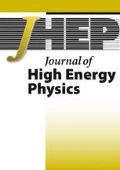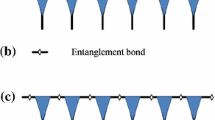Abstract
In (d + 1) dimensional Multiscale Entanglement Renormalization Ansatz (MERA) networks, tensors are connected so as to reproduce the discrete, (d + 2) holographic geometry of Anti de Sitter space (AdS d+2) with the original system lying at the boundary. We analyze the MERA renormalization flow that arises when computing the quantum correlations between two disjoint blocks of a quantum critical system, to show that the structure of the causal cones characteristic of MERA, requires a transition between two different regimes attainable by changing the ratio between the size and the separation of the two disjoint blocks. We argue that this transition in the MERA causal developments of the blocks may be easily accounted by an AdS d+2 black hole geometry when the mutual information is computed using the Ryu-Takayanagi formula. As an explicit example, we use a BTZ AdS3 black hole to compute the MI and the quantum correlations between two disjoint intervals of a one dimensional boundary critical system. Our results for this low dimensional system not only show the existence of a phase transition emerging when the conformal four point ratio reaches a critical value but also provide an intuitive entropic argument accounting for the source of this instability. We discuss the robustness of this transition when finite temperature and finite size effects are taken into account.
Similar content being viewed by others
References
C. Holzhey, F. Larsen and F. Wilczek, Geometric and renormalized entropy in conformal field theory, Nucl. Phys. B 424 (1994) 443 [hep-th/9403108] [SPIRES].
M. Caraglio and F. Gliozzi, Entanglement Entropy and Twist Fields, JHEP 11 (2008) 076 [arXiv:0808.4094] [SPIRES].
P. Calabrese and J.L. Cardy, Entanglement entropy and quantum field theory, J. Stat. Mech. (2004) P06002 [hep-th/0405152] [SPIRES].
S. Ryu and T. Takayanagi, Aspects of holographic entanglement entropy, JHEP 08 (2006) 045 [hep-th/0605073] [SPIRES].
S. Ryu and T. Takayanagi, Holographic derivation of entanglement entropy from AdS/CFT, Phys. Rev. Lett. 96 (2006) 181602 [hep-th/0603001] [SPIRES].
D.V. Fursaev, Proof of the holographic formula for entanglement entropy, JHEP 09 (2006) 018 [hep-th/0606184] [SPIRES].
H. Casini, M. Huerta and R.C. Myers, Towards a derivation of holographic entanglement entropy, JHEP 05 (2011) 036 [arXiv:1102.0440] [SPIRES].
M. Headrick and T. Takayanagi, A holographic proof of the strong subadditivity of entanglement entropy, Phys. Rev. D 76 (2007) 106013 [arXiv:0704.3719] [SPIRES].
O. Aharony, S.S. Gubser, J.M. Maldacena, H. Ooguri and Y. Oz, Large-N field theories, string theory and gravity, Phys. Rept. 323 (2000) 183 [hep-th/9905111] [SPIRES].
L. Susskind and E. Witten, The holographic bound in Anti-de Sitter space, hep-th/9805114 [SPIRES].
S. Furukawa, V. Pasquier and J. Shiraishi, Mutual Information and Compactification Radius in a c = 1 Critical Phase in One Dimension, arXiv:0809.5113 [SPIRES].
P. Calabrese, J. Cardy and E. Tonni, Entanglement entropy of two disjoint intervals in conformal field theory, J. Stat. Mech. (2009) P11001 [arXiv:0905.2069] [SPIRES].
M.W. Wolf, F. Verstraete, M. Hastings and J. Cirac, Area laws in quantum systems: Mutual information and correlations, Phys. Rev. Lett. 100 (2008) 070502 [arXiv:0704.3906].
G. Vidal and R. F. Werner, A computable measure of entanglement, Phys. Rev. A 65 (2002) 032314 [quant-ph/0102117].
H. Wichterich, J. Molina-Vilaplana and S. Bose, Scaling of entanglement between separated blocks in spin chains at criticality, Phys. Rev. A 80 (2009) 010304 [arXiv:0811.1285].
S. Marcovitch, A. Retzker, M.B. Plenio and B. Reznik, Critical and noncritical long-range entanglement in Klein-Gordon fields, Phys. Rev. A 80 (2009) 012325 [arXiv:0811.1288].
H. Casini and M. Huerta, A finite entanglement entropy and the c-theorem, Phys. Lett. B 600 (2004) 142 [hep-th/0405111] [SPIRES].
H. Casini, C.D. Fosco and M. Huerta, Entanglement and alpha entropies for a massive Dirac field in two dimensions, J. Stat. Mech. (2005) P07007 [cond-mat/0505563] [SPIRES].
M. Headrick, Entanglement Rényi entropies in holographic theories, Phys. Rev. D 82 (2010) 126010 [arXiv:1006.0047] [SPIRES].
B.-Q. Jin and V. Korepin, Entanglement entropy for disjoint subsystems in XX spin chain, arXiv:1104.1004 [SPIRES].
S.W. Hawking and D.N. Page, Thermodynamics of Black Holes in anti-de Sitter Space, Commun. Math. Phys. 87 (1983) 577 [SPIRES].
B. Swingle, Entanglement Renormalization and Holography, arXiv:0905.1317 [SPIRES].
B. Swingle, Mutual information and the structure of entanglement in quantum field theory, arXiv:1010.4038 [SPIRES].
G. Evenbly and G. Vidal, Tensor network states and geometry, arXiv:1106.1082 [SPIRES].
G. Vidal, Class of quantum many-body states that can be efficiently simulated, Phys. Rev. Lett. 101 (2008) 110501 [quant-ph/0610099].
G. Vidal, Entanglement renormalization, Phys. Rev. Lett. 99 (2007) 220405 [cond-mat/0512165v2].
D.J. Gross and H. Ooguri, Aspects of large-N gauge theory dynamics as seen by string theory, Phys. Rev. D 58 (1998) 106002 [hep-th/9805129] [SPIRES].
M. Van Raamsdonk, Comments on quantum gravity and entanglement, arXiv:0907.2939 [SPIRES].
J. Haegeman, T.J. Osborne, H. Verschelde and F. Verstraete, Entanglement renormalization for quantum fields, arXiv:1102.5524 [SPIRES].
M. Bañados, C. Teitelboim and J. Zanelli, The Black hole in three-dimensional space-time, Phys. Rev. Lett. 69 (1992) 1849 [hep-th/9204099] [SPIRES].
P. Kraus, Lectures on black holes and the AdS 3 /CFT 2 correspondence, Lect. Notes Phys. 755 (2008) 193 [hep-th/0609074] [SPIRES].
C. Misner, K. Thorne and J. Wheeler, Gravitation, W.H. Freeman, New York U.S.A. (1973).
V. Balasubramanian, I. García-Etxebarria, F. Larsen and J. Simón, Helical Luttinger Liquids and Three Dimensional Black Holes, arXiv:1012.4363 [SPIRES].
J.D. Brown and M. Henneaux, Central Charges in the Canonical Realization of Asymptotic Symmetries: An Example from Three-Dimensional Gravity, Commun. Math. Phys. 104 (1986) 207 [SPIRES].
J. Louko, D. Marolf and S.F. Ross, On geodesic propagators and black hole holography, Phys. Rev. D 62 (2000) 044041 [hep-th/0002111] [SPIRES].
E. Witten, Anti-de Sitter space and holography, Adv. Theor. Math. Phys. 2 (1998) 253 [hep-th/9802150] [SPIRES].
E. Tonni, Holographic entanglement entropy: near horizon geometry and disconnected regions, JHEP 05 (2011) 004 [arXiv:1011.0166] [SPIRES].
D. Birmingham, I. Sachs and S.N. Solodukhin, Relaxation in conformal field theory, Hawking-Page transition and quasinormal/normal modes, Phys. Rev. D 67 (2003) 104026 [hep-th/0212308] [SPIRES].
P.D. Francesco, P. Mathieu and D. Sénéchal, Conformal Field Theory, Springer, New York U.S.A. (1997).
D. Mumford, TATA Lectures on Theta, Birkhauser, Basel Switzerland (1982).
L. Álvarez-Gaumé, G.W. Moore and C. Vafa, Theta functions, modular invariance and strings, Commun. Math. Phys. 106 (1986) 1 [SPIRES].
P. Hayden, M. Headrick and A. Maloney, Holographic Mutual Information is Monogamous, arXiv:1107.2940 [SPIRES].
V. Coffman, J. Kundu and W.K. Wootters, Distributed Entanglement, Phys. Rev. A 61 (2000) 052306 [quant-ph/9907047] [SPIRES].
Author information
Authors and Affiliations
Corresponding author
Additional information
ArXiv ePrint: 1108.1277
Rights and permissions
About this article
Cite this article
Molina-Vilaplana, J., Sodano, P. Holographic view on quantum correlations and mutual information between disjoint blocks of a quantum critical system. J. High Energ. Phys. 2011, 11 (2011). https://doi.org/10.1007/JHEP10(2011)011
Received:
Revised:
Accepted:
Published:
DOI: https://doi.org/10.1007/JHEP10(2011)011



